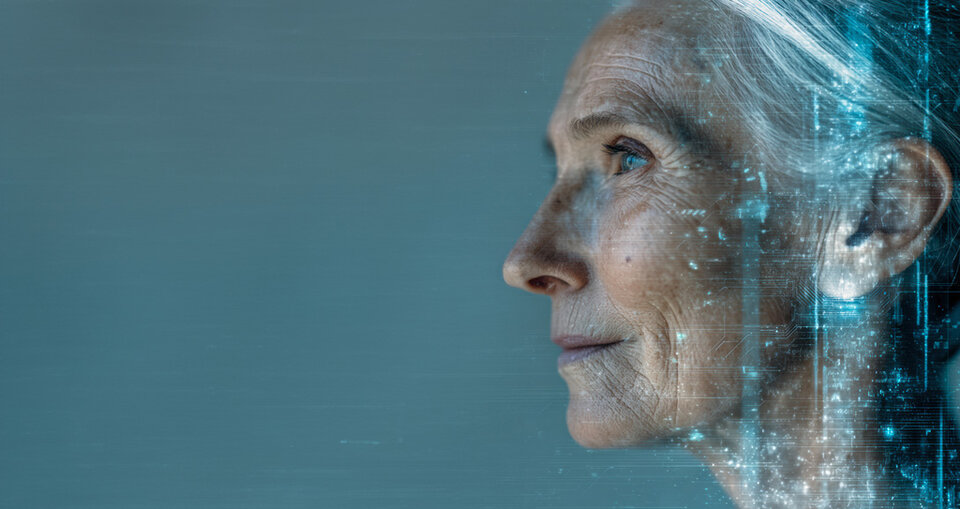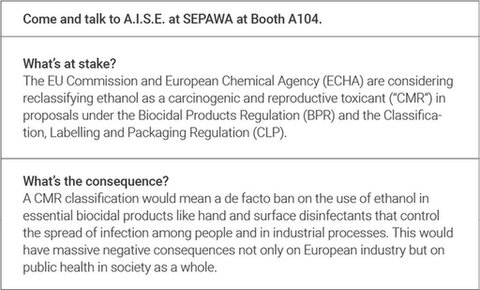COLUMN: BEHIND THE CLAIM
Redefining How We Measure Skin Longevity
KEYWORDS —
Skin longevity science;
Non-invasive skin assessment;
Cellular senescence and skin aging;
Skin biomarkers for aging;
Biomechanical skin analysis;
Oxidative stress and skin damage
“
“A study in healthy women providing probiotic yogurt for four weeks showed an improvement in emotional responses as measured by brain scans”
Introduction
The search for youthful, healthy skin stretches back millennia. Ancient civilizations such as Egypt and Mesopotamia, as well as traditional Chinese and Ayurvedic medicine, used natural oils, herbs and ritualistic practices to preserve vitality and skin health. However, their efficacy, while rooted in cultural wisdom, remains debatable, based more on anecdotal evidence than scientific validation.
The 20th century marked a paradigm shift in skincare, as biomedical research began to explore skin biology at the cellular and molecular levels (1). While early scientific inquiries highlighted the importance of vitamins, antioxidants and collagen, it is now recognized that skin longevity is a complex, multifaceted concept involving not just visible aesthetics but also the preservation of skin’s physiological integrity over time (2). This evolution has transformed skincare from tradition-driven practices into a field grounded in measurable biological science, establishing a foundation for evidence-based interventions aimed at extending skin health and longevity.
The science of skin longevity
Modern research reveals skin longevity as a multi-layered concept encompassing both visible aesthetics and physiological integrity. Central to this is cellular senescence, a state in which skin cells cease dividing and secrete pro-inflammatory factors. The accumulation of these senescent cells in the dermis and epidermis impairs tissue regeneration (3).
Oxidative stress, largely driven by reactive oxygen species from UV radiation and environmental pollutants, damages DNA, lipids and proteins, accelerating functional decline and senescence (4). Telomere shortening, the progressive erosion of protective chromosome end caps during cell division, further limits the regenerative capacity of skin cells (5).
Hormonal changes, particularly decreased estrogen levels with age, reduce collagen synthesis and compromise elastin integrity, diminishing skin firmness and elasticity (6). These intrinsic factors interact with extrinsic influences, such as photoaging, smoking and lifestyle stress, collectively accelerating the visible signs of aging (7).
The integrative understanding forms the biological framework for evaluating skin longevity, guiding the identification of biomarkers and clinical endpoints that objectively measure skin health and aging.

Non-invasive clinical tools to measure skin longevity
Skin longevity is best assessed using objective, reproducible and non-invasive techniques that capture both structural and functional aspects of aging. These tools provide robust evidence for evaluating interventions designed to maintain skin vitality (8, 9).
- Macro imaging – encompasses high-resolution digital photography and advanced three-dimensional (3D) imaging systems to document surface features such as wrinkles, fine lines, texture irregularities, pigmentation and volumetric changes. Standardized high-resolution photography remains widely used due to its accessibility and ability to capture detailed surface changes under controlled conditions (10).
More sophisticated 3D profilometry, including fringe projection and stereometric analysis, generates precise topographical maps of wrinkle depth, skin roughness and volumetric changes (11). Image analysis software translates these maps into quantifiable parameters, supporting longitudinal monitoring and statistical evaluation (12). While imaging effectively captures visible changes, it does not reveal underlying functional or molecular alterations, necessitating complementary assessment techniques. - Biomechanical parameters– the structural integrity of collagen and elastin networks governs skin viscoelasticity (elasticity, firmness, tonicity and suppleness). Age-related degradation of these proteins manifests as sagging, wrinkles and reduced skin elasticity.
Non-invasive instruments such as the cutometer, elastometer and ballistometer quantify these biomechanical properties (13). The cutometer applies negative pressure to measure deformation and recovery, yielding metrics that reflect skin firmness and elasticity. Elastometers assess skin displacement under suction, while ballistometers evaluate bounce-back characteristics after mechanical impact, providing complementary biomechanical insights.
Clinical studies consistently show decreased elasticity with advancing age and photoaging, establishing biomechanical metrics as critical endpoints for evaluating skin longevity treatments. Measurements are influenced by factors such as hydration status, anatomical site, measurement pressure and environmental conditions, emphasizing the need for standardized protocols. - Hydration and barrier function – proper hydration maintains epidermal plasticity, supports repair mechanisms and protects against environmental stressors, slowing the aging process. Skin surface hydration and trans-epidermal water loss (TEWL) measurements are primary non-invasive biophysical techniques for assessing these parameters (14, 15). Skin hydration is typically assessed by measuring electrical properties (impedance or capacitance), which correlate directly with hydration levels. TEWL meters quantify the passive water evaporation, an inverse indicator of barrier integrity – higher values reflect compromised barriers, typical of aged or damaged skin.
Age-related decline in skin hydration levels and increased TEWL contribute to visible dryness, rough texture and susceptibility to irritants, accelerating visible and functional aging (16, 17). Advanced non-invasive methods like in vivo confocal Raman spectroscopy enable layered quantification of water distribution within skin strata, providing nuanced insights into hydration dynamics and barrier quality (18). - Biomarker analysis – non-invasive sampling of the stratum corneum via tape stripping or swabbing allows analysis of molecular biomarkers reflecting skin health and aging. Tape stripping sequentially removes corneocytes and extracellular lipid material, while swabbing collects proteins, lipids and microbiota. These approaches are well-suited for longitudinal monitoring and clinical trials.
Key biomarkers include:
- Inflammatory cytokines (e.g. interleukins, IFN-γ, TNF-α): indicators of chronic low-grade inflammation (‘inflammaging’)(19)
- Oxidative stress markers (e.g. malondialdehyde, 8-OHdG): reflecting reactive oxygen species-induced damage to DNA, lipids and proteins
- Matrix metalloproteinases: enzymes responsible for collagen and elastin degradation
- Barrier lipids (e.g. ceramides): essential for barrier function and hydration
- Microbiome alterations: influence immune defense and skin barrier regulation
Quantifying these markers enables a multi-level understanding of biological skin age and intervention efficacy. Reductions in pro-inflammatory markers coupled with normalized ceramide levels correlate with improved barrier function and clinical appearance (20).
High-throughput multiplex immunoassays and omics technologies allow systems biology approaches that integrate molecular data with clinical endpoints, providing a comprehensive evaluation of interventions targeting longevity pathways.
Integrating clinical insights to validate skin longevity
Effective assessment of skin longevity requires a multi-dimensional approach combining macro imaging, biomechanical measurements, hydration and barrier evaluation and molecular biomarker analysis. This framework captures visible, functional and molecular aspects of aging, providing objective evidence of intervention efficacy.
Macro imaging visualizes wrinkles, texture and volume, while biomechanical measurements reflect collagen and elastin integrity. Hydration and barrier assessments reveal physiological resilience and molecular biomarkers uncover inflammation, oxidative stress and matrix degradation.
Integrating these methods allows researchers to quantify improvements across structural, functional and molecular levels, substantiating product claims with scientific rigor. Advances in imaging, omics and standardized protocols enhance precision and predictive power, offering transparent, evidence-based insights into interventions that preserve skin vitality.
By bridging traditional knowledge with modern molecular science, these integrated clinical strategies validate visible improvements while revealing deeper biological changes, supporting innovation and consumer trust in the evolving field of skin longevity.


About A.I.S.E.
A.I.S.E. represents the detergents & maintenance products industry in Europe. Based in Brussels, A.I.S.E. has been the voice of the industry to EU regulators since 1952. Membership consists of 20 corporate members, 30 national associations across Europe and 19 value chain partners. Through this extensive network, A.I.S.E. represents over 900 companies supplying household and professional cleaning products and services across Europe.
A.I.S.E. is committed to promoting sustainable practices and innovation and collaborates closely with the European institutions, industry stakeholders and the public to enhance the sector’s environmental protection, consumer safety, and regulatory compliance efforts.
Read more about how ethanol keeps us safe on www.aise.eu/ethanol
Studies of major depressive disorder have been correlated with reduced Lactobacillus and Bifidobacteria and symptom severity has been correlated to changes in Firmicutes, Actinobacteria, and Bacteriodes. Gut microbiota that contain more butyrate producers have been correlated with improved quality of life (1).
A study in healthy women providing probiotic yogurt for four weeks showed an improvement in emotional responses as measured by brain scans (2). A subsequent study by Mohammadi et al. (3) investigated the impacts of probiotic yogurt and probiotic capsules over 6 weeks and found a significant improvement in depression-anxiety-stress scores in subjects taking the specific strains of probiotics contained in the yogurt or capsules. Other studies with probiotics have indicated improvements in depression scores, anxiety, postpartum depression and mood rating in an elderly population (4-7).
Other studies have indicated a benefit of probiotic supplementation in alleviating symptoms of stress. In particular, researchers have looked at stress in students as they prepared for exams, while also evaluating other health indicators such as flu and cold symptoms (1). In healthy people, there is an indication that probiotic supplementation may help to maintain memory function under conditions of acute stress.
References and notes
- Farage MA, Miller KW, Elsner P, Maibach HI. Intrinsic and extrinsic factors in skin ageing: a review. Int J Cosmet Sci. 2008 Oct;30(2):87-95
- Klinngam W, Chaiwichien A, Osotprasit S, Ruktanonchai U, Kanlayavattanakul M, Lourith N, Wongrakpanich A, Teeranachaideekul V, Iempridee T. Longevity cosmeceuticals as the next frontier in cosmetic innovation: a scientific framework for substantiating product claims. Frontiers in Aging. 2025 May 22;6:1586999
- Campisi J, d'Adda di Fagagna F. Cellular senescence: when bad things happen to good cells. Nat Rev Mol Cell Biol. 2007 Sep;8(9):729-40
- Pinnell SR. Cutaneous photodamage, oxidative stress, and topical antioxidant protection. J Am Acad Dermatol. 2003 Jan;48(1):1-19
- Buckingham EM, Klingelhutz AJ. The role of telomeres in the ageing of human skin. Exp Dermatol. 2011 Apr;20(4):297-302
- Brincat M. Hormone replacement therapy and the skin. Maturitas. 2000;35(2):107-17
- Rittié L, Fisher GJ. Natural and sun-induced aging of human skin. Cold Spring Harb Perspect Med. 2015 Nov 2;5(1):a015370
- Dobos G, Lichterfeld A, Blume-Peytavi U, Kottner J. Evaluation of skin ageing: a systematic review of clinical skin ageing scales. Br J Dermatol. 2015;172(5):1249-1261
- Bielfeldt S, Springmann G, Seise M, Wilhelm KP, Callaghan T. An updated review of clinical methods in the assessment of ageing skin - New perspectives and evaluation for claims support. Int J Cosmet Sci. 2018;40(4):348-360
- Wilhelm KP, Elsner P, Berardesca E, Maibach HI, editors. Bioengineering of the skin: skin imaging & analysis. CRC press; 2006 Sep 27
- Artopoulos A, Buytaert JA, Dirckx JJ, Coward TJ. Comparison of the accuracy of digital stereophotogrammetry and projection moiré profilometry for three-dimensional imaging of the face. Int J Oral Maxillofacial Surg. 2014 May 1;43(5):654-62
- Hamer MA, Jacobs LC, Lall JS, Wollstein A, Hollestein LM, Rae AR, Gossage KW, Hofman A, Liu F, Kayser M, Nijsten T. Validation of image analysis techniques to measure skin aging features from facial photographs. Skin Res Technol. 2015 Nov;21(4):392-402
- Woo MS, Moon KJ, Jung HY, Park SR, Moon TK, Kim NS, Lee BC. Comparison of skin elasticity test results from the Ballistometer® and Cutometer®. Skin Res Technol. 2014 Nov;20(4):422-8
- Verdier‐Sévrain S, Bonté F. Skin hydration: a review on its molecular mechanisms. J Cosm Dermatol. 2007 Jun;6(2):75-82
- Klotz T, Ibrahim A, Maddern G, Caplash Y, Wagstaff M. Devices measuring transepidermal water loss: A systematic review of measurement properties. Skin Res Technol. 2022 Jul;28(4):497-539
- Boireau‐Adamezyk E, Baillet‐Guffroy A, Stamatas GN. The stratum corneum water content and natural moisturization factor composition evolve with age and depend on body site. Int J Dermatol. 2021:60(7), 834-839
- Boireau‐Adamezyk E, Baillet‐Guffroy A, Stamatas GN. Age‐dependent changes in stratum corneum barrier function. Skin Res Technol. 2014 Nov;20(4):409-15
- Caspers PJ, Lucassen GW, Bruining HA, Puppels GJ. Automated depth‐scanning confocal Raman microspectrometer for rapid in vivo determination of water concentration profiles in human skin. J Raman Spectroscopy. 2000 Aug 1;31(8‐9):813-8
- Yadav E. Inflammation and Aging: The Skin Inflammasome in the Context of Longevity Science. J Cell Immunol. 2025 Apr 14;7(2):37-42
- Wang Z, Man MQ, Li T, Elias PM, Mauro TM. Aging-associated alterations in epidermal function and their clinical significance. Aging (Albany NY). 2020 Mar 27;12(6):5551
